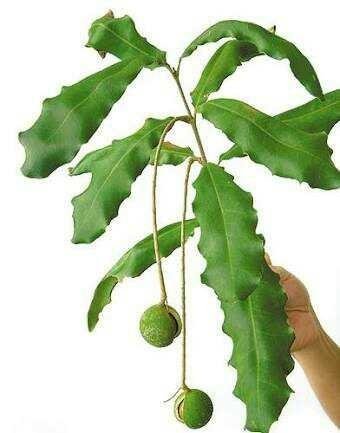Makadamia is a tree with bright brown smooth-colored stems, which can grow to as high as 20 m. The shape of the macadamia header is irregular. The shape of this canopy is influenced by its irregular branching form. Makadamia leaves are dark green, with glossy slick surface. The shape of a lanceolate leaves like a small mace. The leaf tip is rounded, wider than the base. Leaf length 15 cm, with width 5 cm. The macadamia flower is shaped like a soft 15 cm long brush, with colors ranging from white, pink, purpel, and four-headed. Flowers out of one armpit dain on small twigs. 
The fruit of macadamia grows on the flower stalk of dompolan. The size and shape of the macadamia fruit, similar to duku duku, only the macadamia stalk is longer, and the skin tones are dark green. The soft part of the skin of macadamia is very thin, then a very hard shell, although only about 1 mm thick. Inside this shell there is "macadamia nuts" round, 3cm diameter yellowish white, soft and tasty. Makadamia is indeed one of the important nut producing plants (nut). Other nut commodities are chest nut (castanea), cashew nut (cashew), and almonds.
Makadamia is cultivated primarily for harvesting its macadamian nuts. Although many also use it as an ornamental plant. Both as a garden element (shade plants), as well as ornamental plants in pots. This last use is mainly done by people in cold climates. Once harvested and broken down the shell, macadamia seeds are fried (with oil or diesel), then packed and marketed. In addition to being marketed in the form of a regular nut, macadamia is also a round chocolate filler, with whole seeds macadamia in it. Until the economic value of macadamia is quite high.
Makadamia is a native plant of the Proteaceae family, the genus Macadamia F. Muell, which consists of eight species. Seven species are native to eastern Australia, Macadamia claudiensis; Macadamia grandis; Macadamia integrifolia; Macadamia jansenii; Macadamia ternifolia; Macadamia tetraphylla; and Macadamia whelanii. One species comes from Indonesia (Sulawesi), namely Macadamia hildebrandii. This plant genus is named macadamia, in honor of the botanist who once studied it, namely John Macadam. Other names are Queensland nut, Bush nut, and Maroochi nut. Aboriginal people, calling it the Kindal Kindal and Jindilli names.

Of the eight species of macadamia, only two species of M. integrifolia and M. tetraphylla, are cultivated commercially. Two macadamia specifications are even toxic, namely M. whelanii and M. ternifolia. However, the cyanogenic glycosides, which are contained in the seeds, can be neutralized by longer drying and frying processes. Aboriginal people continue to consume these two species of macadamia, because they know very well how to neutralize the poison. The current cultivated macadamia is generally a hybrid between M. integrifolia or M. tetraphylla, with very rare M. tetraphylla, found in Bauple Mountain, near Maryborough, southeast of Queensland.
In Indonesia, macadamia plants can be found in Cibodas Botanical Garden, Cianjur, West Java, macadamia can also grow well and bear fruit, can also be found in macadamia plants Horticulture Research Center in Cikole, Lembang, Bandung. Currently, it has been seriously cultivated in Kalisat Jampit Plantation, and Sempol Plantation in Ijen highlands, Bondowoso, East Java. In this plantation, macadamia is already bearing fruit and already processed, although the volume is still very limited and only sold in the location of the garden to the tourists. Until now, these two estates still continue to nurture macadamia to multiply the plant population. In this plantation, macadamia is planted on the edge of the coffee plant, and on slopes that coffee can not possibly plant.
As perennials, the new macadamia will begin to bear fruit at the age of 7 to 10 years. The weakness of macadamia is shallow rooting, until the tree is easily fallen when hit by the wind. The roots of macadamia are also susceptible to Phytophthora fungi. The fruit itself, often targeted by larvae attack (caterpillars) Lepidoptera, including Batrachedra arenosella. However, on plantations with commercial scela, these fungi and larvae attacks can be controlled at a cost that is still mitigated by the results of the macadamia itself. Waste macadamia shell, usually used as a fuel in the process of fleshing flesh. Makadamia wood is also very hard, until the results of branch pruning, can be used for charcoal.
To the question in your title, my Magic 8-Ball says:
Hi! I'm a bot, and this answer was posted automatically. Check this post out for more information.